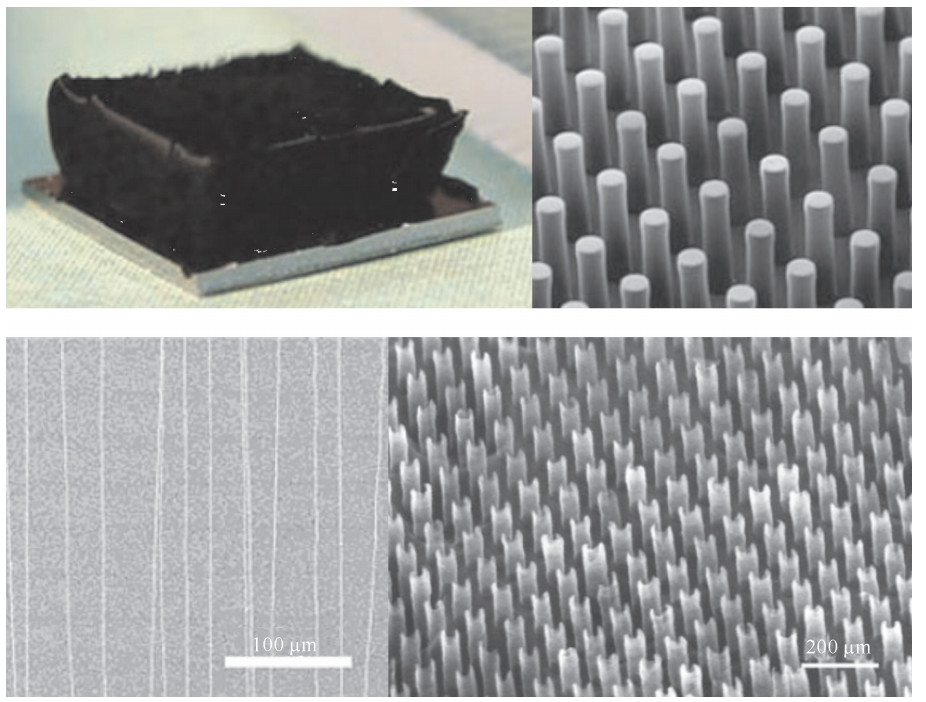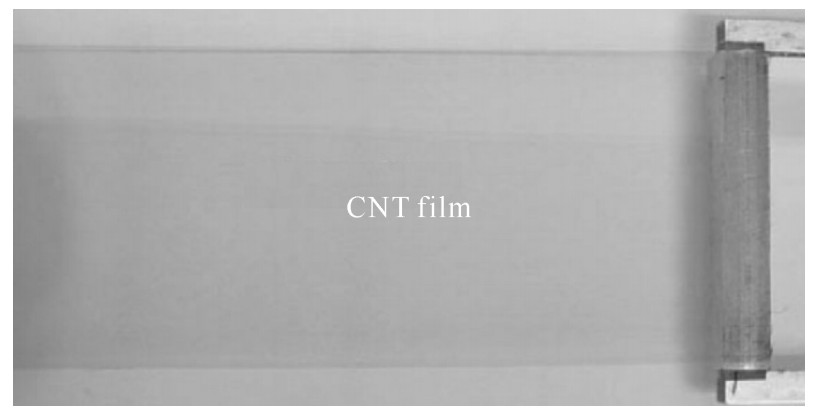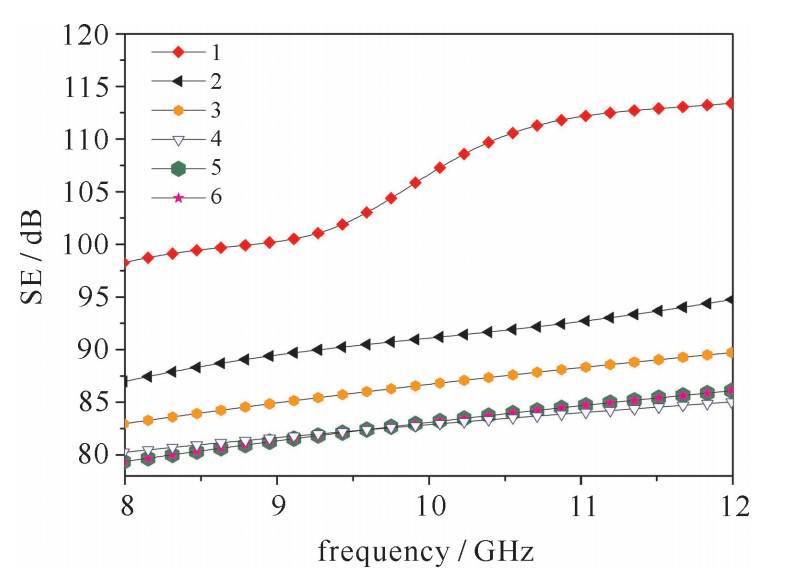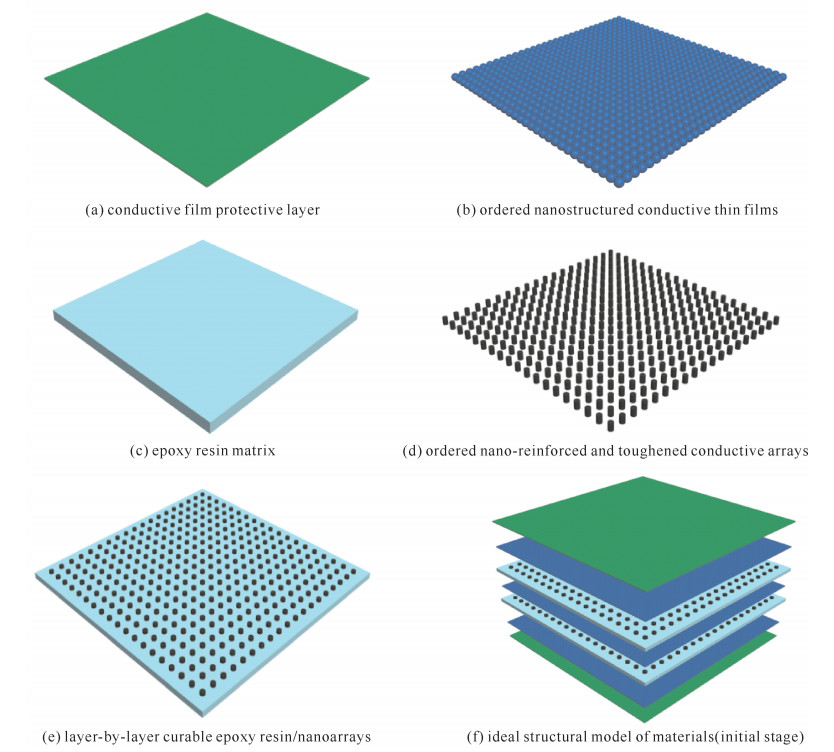Study on epoxy resin-based carbon nanocomposite for electromagnetic shielding
-
摘要: 基于碳纳米材料有序结构优异的结构与功能特点,研究了其在新型电磁防护材料中的应用,结合环氧树脂与碳纳米有序结构在电磁屏蔽效能和力学性能方面表现出的显著优势,论述了环氧树脂基碳纳米管复合电磁屏蔽材料和碳纳米管有序纳米结构研究,通过电磁仿真优化设计构筑三维导电网络结构,得出8~12 GHz电磁波段屏蔽效能≥82.96 dB的理想结构模型,为环氧树脂基碳纳米复合电磁屏蔽材料研究开发提供了指导,有利于该新型电磁屏蔽材料在国防、国民经济各领域的应用。Abstract: The epoxy resin is widely applied in the fields of national defense and economy because of its high bonding strength to the metallic and non-metallic surface after solidification. The carbon nanomaterials, especially the ordered structures of carbon nanomaterial with excellent structure and performance, are widely used in the research of new electromagnetic protection material. The combination of epoxy resin and the ordered structure carbon nanomaterials shows obvious advantage in the aspects of electromagnetic shielding effectiveness and mechanical property. On the basis of the epoxy resin/carbon nanotube electromagnetic shielding composite materials and the ordered carbon nanotube structures' researches, the ideal structure model with electromagnetic shielding property ≥82.96 dB in the range of 8-12 GHz is obtained through optimal design of electromagnetic simulation and structure fabrication of electrical conductivity three-dimensional network. This investigation provides guidance for researching electromagnetic shielding composite based on epoxy resin and carbon nanomaterials.
-
Key words:
- carbon nanotube /
- epoxy resin /
- electromagnetic shield /
- ideal model /
- ordered structure
-
表 1 环氧树脂基体中掺杂碳纳米管渗透阈值及导电性
Table 1. Permeation threshold and conductivity of doped carbon nanotubes in epoxy resin matrix
No CNT types dispersivity length-diameter ratio percolation threshold/% σmax/(S·m-1) 1 MWCNT/CVD non-entangled 200 0.0021 1×10-3/0.01% 2 MWCNT/CVD non-entangled 340 0.0025 2×100/1% 3 MWCNT/CVD non-entangled 1000 0.0025 4×10-1/0.5% 4 SWCNT/Laser method entangled 400 0.01 5×10-3/0.4% 5 MWCNT/CVD entangled 1000 0.024 3×10-1/1% 6 MWCNT/CVD entangled 100 0.03 5×10-1/0.15% 7 SWCNT/CVD / 1000 0.04 1×10-3/0.4% 8 SWCNT/Arc method entangled 5000 0.074 1×10-3/0.2% 9 DWCNT/CVD entangled 1000 0.15 1×10-2/0.6% 10 MWCNT/CVD entangled 100 0.6 5×10-3/10% 11 SWCNT/ Arc method entangled 1000 0.6 1×10-2/14% 12 MWCNT/CVD / >500 0.7 5×100/4% 13 MWCNT/CVD entangled 80 1.5 1×10-3/3% 14 MWCNT/ Arc method entangled 100 4 1×10-3/16% 15 MWCNT/CVD / >20 5 2×10-5/20% 16 MWCNT/CVD / 20 5 1×10-5/8% 表 2 环氧树脂基电磁屏蔽材料屏蔽效能仿真计算结果
Table 2. Simulation results of shielding effectiveness of epoxy resin-based electromagnetic shielding materials
No electronic conductivity/(S·m-1) thickness/mm square resistance/Ω layer number shielding effectiveness/dB 1 2 50 / 0 ≥98.27 2 300 3 / 0 ≥86.98 3 2 3 5/5/5 3 ≥82.96 4 2 10 4/4 2 ≥80.25 5 2 3 4/6/8 3 ≥79.38 6 2 3 8/6/4 3 ≥79.38 -
[1] Gajsek P, Ravazzani P, Wiart J, et al. Electromagnetic field exposure assessment in Europe radiofrequency fields (10 MHz-6 GHz)[J]. J Expo Sci Environ Epidemiol, 2015, 25(1): 37-44. doi: 10.1038/jes.2013.40 [2] Carlberg M, Koppel T, Ahonen M, et al. Case-control study on occupational exposure to extremely low-frequency electromagnetic fields and glioma risk[J]. Am J Ind Med, 2017, 60(5): 494-503. doi: 10.1002/ajim.22707 [3] Zou T, Shi C, Zhao N. Microwave absorbing properties of the Archimedean plane spiral antenna array/epoxy resin composites[J]. Materials Science and Engineering B, 2007, 142: 51-54. doi: 10.1016/j.mseb.2007.06.006 [4] Oh J Hn, Oh K S, Kim C G. Design of radar absorbing structures using glass/epoxy composite containing carbon black in X-band frequency ranges[J]. Composites: Part B, 2004, 35: 49-56. doi: 10.1016/j.compositesb.2003.08.011 [5] Iwamaru T, Katsumata H, Uekusa S. Development of microwave absorbing materials prepared from a polymer binder including Japanese lacquer and epoxy resin[J]. Physics Procedia, 2012, 23: 69-72. doi: 10.1016/j.phpro.2012.01.018 [6] Biswas S, Panja S S, Bose S. Tailored distribution of nanoparticles in biphasic polymeric blends as emerging materials for suppressing electromagnetic radiation: challenges and prospects[J]. J Mater Chem C, 2018, 13 (6) : 3120-3142. [7] Lü L, Liu J, Liu H, et al. An overview of electrically conductive polymer nanocomposites toward electromagnetic interference shielding[J]. Eng Sci, 2018, 2: 26-42. [8] Wan Y J, Zhu P L, Yu S H, et al. Graphene paper for exceptional EMI shielding performance using large-sized graphene oxide sheets and doping strategy[J]. Carbon, 2017, 122: 74-81. doi: 10.1016/j.carbon.2017.06.042 [9] Shishkin A, Koppel T, Mironov V, et al. Microwave reflectance and transmittance properties of conductive composite materials[J]. Energy Procedia, 2017, 113: 354-361. doi: 10.1016/j.egypro.2017.04.006 [10] Mondal S, Nayak L, Rahaman M, et al. An effective strategy to enhance mechanical, electrical, and electromagnetic shielding effectiveness of chlorinated polyethylene-carbon nanofiber nanocomposites[J]. Compos B Eng, 2017, 109: 155-169. doi: 10.1016/j.compositesb.2016.10.049 [11] Li M, Xiao S Q, Bai Y Y, et al. An ultrathin and broadband radar absorber using resistive FSS[J]. IEEE Antennas and Wireless Propagation Letters, 2012, 11: 748-751. doi: 10.1109/LAWP.2012.2206361 [12] Noor A, Hu Z. Metamaterial dual polarised resistive Hilbert curve array radar absorber[J]. Microw Antennas Propag, 2010, 4(6): 667-673. doi: 10.1049/iet-map.2009.0047 [13] Zhou E, Xi J, Gao C, et al. Synergistic effect of graphene and carbon nanotube for high-performance electromagnetic interference shielding films[J]. Carbon, 2018, 133: 316-322. doi: 10.1016/j.carbon.2018.03.023 [14] Wang C, Murugadoss V, Kong J, et al. Overview of carbon nanostructures and nanocomposites for electromagnetic wave shielding[J]. Carbon, 2018, 140: 696-733. doi: 10.1016/j.carbon.2018.09.006 [15] Zeng Z, Jin H, Chen M, et al. Lightweight and anisotropic porous MWCNT/WPU composites for ultrahigh performance electromagnetic interference shielding[J]. Adv Funct Mater, 2016, 26(2): 303-310. doi: 10.1002/adfm.201503579 [16] Chen Z, Xu C, Ma C, et al. Lightweight and flexible grapheme foam composites for high-performance electromagnetic interference shielding[J]. Adv Mater, 2013, 25(9) : 1296-1300. doi: 10.1002/adma.201204196 [17] Zhao D L, Li X, Shen Z M. Electromagnetic and microwave absorbing properties of multi-walled-carbon nanotubes filled with Ag nanowires[J]. Mat Sci Eng B, 2008, 150(2): 105-110. doi: 10.1016/j.mseb.2008.04.004 [18] Fan Z J, Lou G H, Zhang Z F, et al. Electromagnetic and microwave absorbing properties of multiwalled carbon nanotubes/polymer composites[J]. Mat Sci Eng B, 2006, 132(1/2): 85-89. [19] Sandler J K W, Kirk J E, Kinloch I A, et al. Ultra-low electrical percolation threshold in carbon-nanotube-epoxy composites[J]. Polymer, 2003, 44(19): 5893-5899. doi: 10.1016/S0032-3861(03)00539-1 [20] Martin C A, Sandler J K W, Shaffer M S P, et al. Formation of percolating networks in multi-wall carbon nanotube-epoxy composites[J]. Compos Sci Technol, 2004, 64(15): 1236-2309. [21] Moisala A, Li Q, Kinloch IA, et al. Thermal and electrical conductivity of single- and multi-walled carbon nanotube-epoxy composites[J]. Compos Sci Technol, 2006, 66(10): 1285-1288. doi: 10.1016/j.compscitech.2005.10.016 [22] Liu L, Matitsine S, Gan Y B, et al. Frequency dependence of effective permittivity of carbon nanotube composites[J]. J Appl Phys, 2007, 101: 094106. doi: 10.1063/1.2728765 [23] Yuen S M, Ma C C M, Wu H H, et al. Preparation and thermal, electrical, and morphological properties of multiwalled carbon nanotube and epoxy composites[J]. J Appl Polym Sci, 2007, 103(2): 1272-1278. doi: 10.1002/app.25140 [24] Wichmann M H G, Sumfleth J, Fiedler B, et al. Multiwall carbon nanotube/epoxy composites produced by a masterbatch process[J]. Mech Comp Ma, 2006, 42(5): 395-406. doi: 10.1007/s11029-006-0050-3 [25] Boncel S, Krzysztof K K, Walczak K Z, et al. Infiltration of highly aligned carbon nanotube arrays with molten polystyrene[J]. Materials Letters, 2011, 65: 2299-2303. doi: 10.1016/j.matlet.2011.04.065 [26] Bauhofer W, Kovacs J Z. A review and analysis of electrical percolation in carbon nanotube polymer composites[J]. Composites Science and Technology, 2009, 69: 1486-1498. doi: 10.1016/j.compscitech.2008.06.018 [27] 李克训, 马江将, 赵亚丽, 等. 垂直定向碳纳米管的化学气相沉积法制备及其应用进展[J]. 材料导报, 2016, 30(11): 27-32. https://www.cnki.com.cn/Article/CJFDTOTAL-CLDB201621005.htmLi Kexun, Ma Jiangjiang, Zhao Yali, et al. Progress in fabrication and application of vertically aligned carbon nanotubes by chemical vapor deposition. Materials Reports, 2016, 30(11): 27-32. https://www.cnki.com.cn/Article/CJFDTOTAL-CLDB201621005.htm [28] Hata K, Futaba D N, Iijima S, et al. Water-assisted highly efficient synthesis of impurity-free single-walled carbon nanotubes[J]. Science, 2004, 306(5700): 1362-1364. doi: 10.1126/science.1104962 [29] Zhang G, Mann D, Zhang L, et al. Ultra-high-yield growth of vertical single-walled carbon nanotubes: hidden roles of hydrogen and oxygen[J]. Proc Nat Acad Sci, 2005, 102(45): 16141-16145. doi: 10.1073/pnas.0507064102 [30] Fan S, Chapline M G, Franklin N R, et al. Self-oriented regular arrays of carbon nanotubes and their field emission properties[J]. Science, 1999, 283(5401): 512-514. doi: 10.1126/science.283.5401.512 [31] Chen X Q, Saito T, Yamada H, et al. Aligning single-wall carbon nanotubes with an alternating-current electric field[J]. Appl Phys Lett, 2001, 78(23): 3714-3716. doi: 10.1063/1.1377627 [32] Heremans J, Olk C H, Morelli D T. Magnetic susceptibility of carbon structures[J]. Phys Rev B, 1994, 49(21): 15122-15125. doi: 10.1103/PhysRevB.49.15122 [33] Yoon D K, Lee S R, Kim Y H, et al. Large-area, highly aligned cylindrical perfluorinated supramolecular dendrimers using magnetic fields[J]. Adv Mater, 2006, 18(4): 509-513. doi: 10.1002/adma.200501609 [34] Zhang M, Fang S, Zakhidov A A, et al. Strong, transparent, multifunctional, carbon nanotube sheets[J]. Science 2005, 309(5738): 1215-1219. doi: 10.1126/science.1115311 [35] Zhang M, Atkinson K R, Baughman R H. Multifunctional carbon nanotube yarns by downsizing an ancient technology[J]. Science 2004, 306(5700): 1358-1361. doi: 10.1126/science.1104276 [36] Liu P, Liu L, Fan S, et al. Fast high-temperature response of carbon nanotube film and its application as an incandescent display[J]. Adv Mater, 2009, 21(35): 3563-3566. doi: 10.1002/adma.200900473 [37] Jiang S, Hou P X, Chen M L, et al. Ultrahigh-performance transparent conductive films of carbon-welded isolated single-wall carbon nanotubes[J]. Sci Adv 2018, 4: 9264. doi: 10.1126/sciadv.aap9264 [38] 钟铭龙, 黄玮, 王朝阳. 等. 辐射发制备Pd掺杂碳气凝胶粉末[J]. 强激光与粒子束, 2015, 25(3): 633-636 doi: 10.3788/HPLPB20132503.0633Zhong Minglong, Huang Wei, Wang Chaoyang, et al. Preparation of Pd-doped carbon aerogel power with radiation method. High Power Laser and Particle Beams, 2015, 25(3): 633-636 doi: 10.3788/HPLPB20132503.0633 [39] Arjmand M, Chizari K, Krause B, et al. Effect of synthesis catalyst on structure of nitrogen-doped carbon nanotubes and electrical conductivity and electromagnetic interference shielding of their polymeric nanocomposites[J]. Carbon, 2016, 98: 358-372. doi: 10.1016/j.carbon.2015.11.024 -





 下载:
下载:






